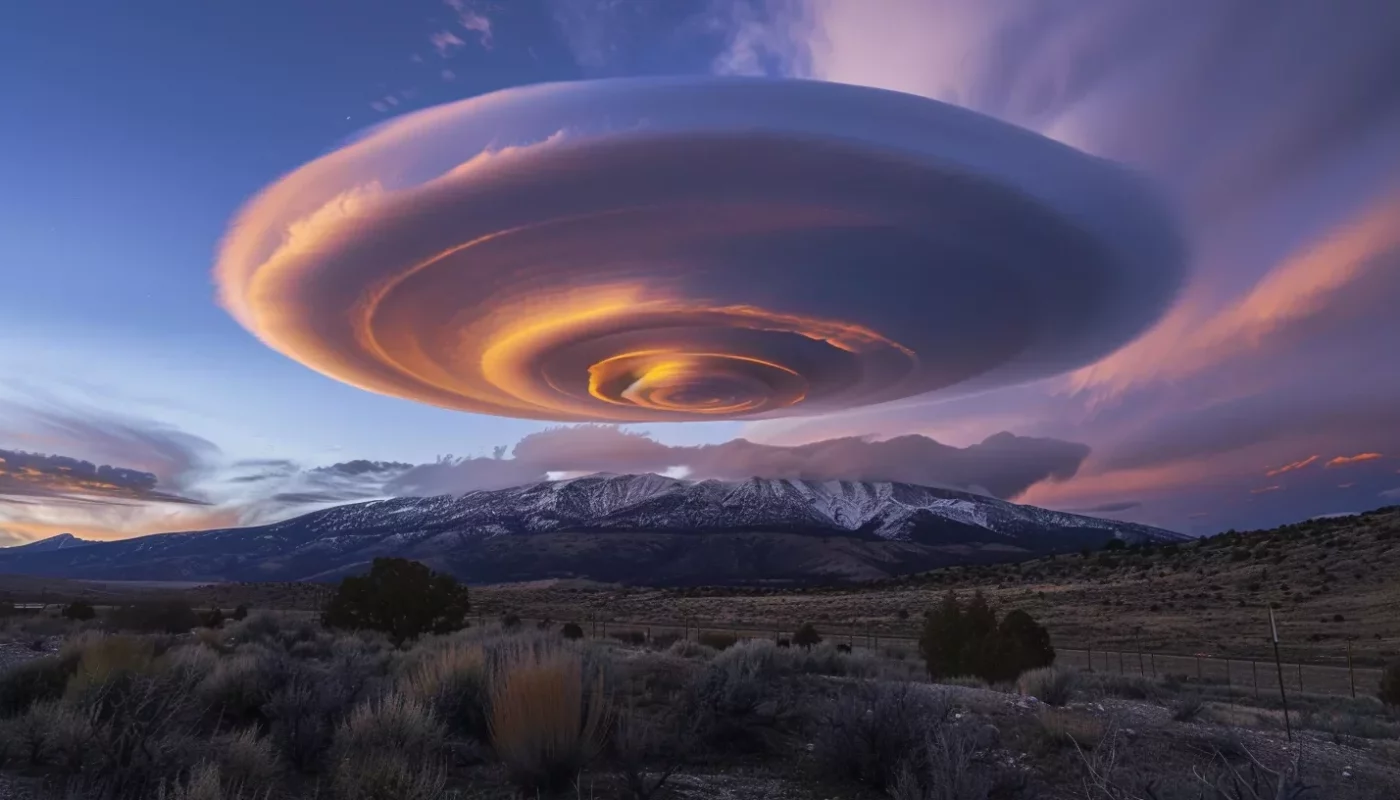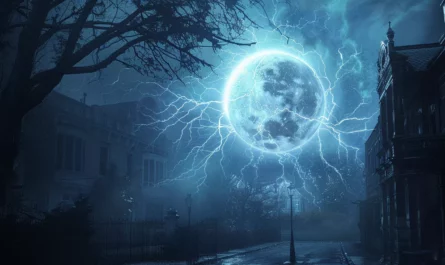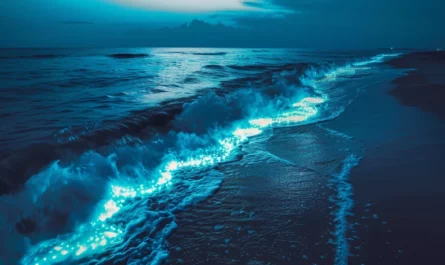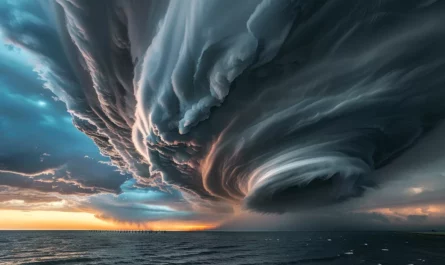Did you know that lenticular clouds look like UFOs? These lens-shaped clouds are often mistaken for space crafts. They form when stable air moves over mountains or hills, creating waves. Lenticular clouds can be found high up, between 6,500 and 16,500 feet. They have a unique curved layer that makes them even more mysterious.
There are different types, like altocumulus standing lenticular (ACSL). Also, stratocumulus standing lenticular (SCSL), and cirrocumulus standing lenticular (CCSL). They show where mountain waves are in the air. Though they look like UFOs, these clouds don’t bring rain. They are a stunning part of nature’s sky shows.
Lenticular clouds don’t need special protection. But, they remind us to care for the places they appear over. Mountains and hills help make them. By protecting these areas, we keep seeing these amazing clouds. They teach us about nature’s magic and why we must protect it.
Formation of Lenticular Clouds
Lenticular clouds form in a unique way. They look like lenses and catch many eyes. They come to life when air flows over mountains, creating waves. If the air has enough moisture, the waves make water vapor condense. This forms the lenticular clouds we see.
These clouds usually form behind hills or mountains. They need stable, fast-moving air to take shape. The layers inside these clouds form a lens shape. That’s why these clouds stand out so much.
The creation of lenticular clouds shows how amazing nature is. When moisture and atmospheric waves mix, they form these incredible clouds.
Lenticular clouds often look like UFOs, amazing people who see them. They show the beauty and mystery of our world. They remind us that simple things can make something beautiful.
Weather Associated with Lenticular Clouds
Lenticular clouds are more than just a pretty sight in the sky; they tell us about the weather. They show us mountain waves in the air. These are signs of atmospheric waves that go beyond the clouds.
The air moves over hills or mountains to create these waves. This movement can cause windy and rough conditions in certain places. Lenticular clouds form because of these mountain waves. They warn us about possible rough winds ahead.
Pilots flying planes usually stay away from these clouds because of the bumpy ride. However, glider pilots like these clouds because they mean rising air. This rising air can help them fly higher and longer.
“Lenticular clouds are nature’s way of revealing the invisible forces at work in the atmosphere. Their presence reminds us of the power and dynamism of mountain waves and the ever-changing nature of our skies.” – Meteorologist Sarah Johnson
Lenticular clouds show how the atmosphere and the land work together. They reveal the stunning power and beauty of nature.
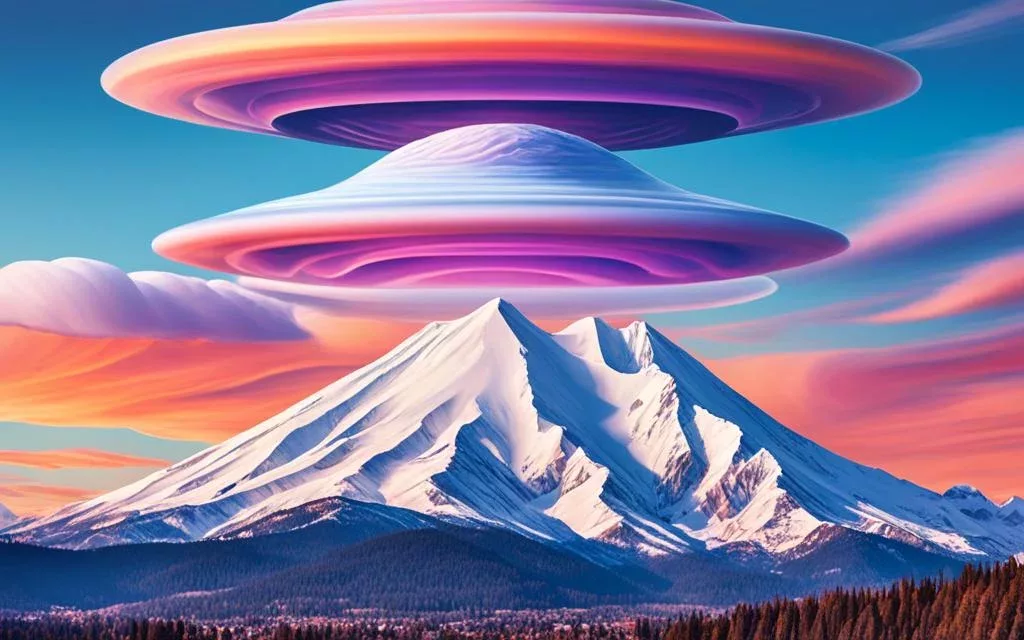
The Impact of Conservation
Keeping the places where lenticular clouds form is essential for these clouds and our planet. Saving mountains and hills helps keep the needed conditions for these clouds.
This protection keeps mountain waves happening in the air, which means more lenticular clouds. It also helps the overall health of the ecosystem. It supports different kinds of life and protects our natural resources for the future.
Types of Lenticular Clouds
Lenticular clouds are known for their lens-like shapes. They have three main types, depending on how high they form above the ground:
- Altocumulus standing lenticular (ACSL): These clouds are found at mid-level altitudes, between 6,500 and 16,500 feet. They look like elongated layers in the sky.
- Stratocumulus standing lenticular (SCSL): These form closer to the surface, at lower altitudes. They appear rounded or flat, with clear layers.
- Cirrocumulus standing lenticular (CCSL): These are at higher altitudes. They create thin, delicate layers against the blue sky.
Each type of lenticular cloud has its own characteristics, looks, and surrounding atmospheric conditions.
Check out the image below to see the various types of lenticular clouds:
“Lenticular clouds are a stunning display of nature’s art. They come in diverse shapes at different altitudes. From elongated, layered altocumulus standing lenticular, to rounded stratocumulus, and the thin cirrocumulus standing lenticular, they amaze everyone who looks up.”
Knowing about the different types of lenticular clouds lets us better appreciate these wonders. Their varying looks show the complex beauty of nature.
Captivating Sightings of Lenticular Clouds
Lenticular clouds always grab our attention with their amazing, out-of-this-world look. Recently, a huge cloud that looked like a UFO appeared in the sky over New Hampshire. It was a sight to see, and photos quickly spread online.
The stunning photos from New Hampshire showed how beautiful lenticular clouds can be. The cloud’s big size and unique shape were incredible. Nature’s forces and the right weather conditions made this beautiful scene possible.
The photos let people see this amazing cloud from where they were. They showed the beauty and wonder in nature’s works.
Lenticular clouds make the sky look amazing. They remind us of the beautiful sights above us. These clouds are fascinating not just for their size, but also for how they make us feel curious and amazed.
| Keywords | Occurrences |
|---|---|
| Stunning photos | 1 |
| Massive cloud formation | 1 |
| New Hampshire | 2 |
Conservation of Lenticular Clouds
Lenticular clouds don’t need to be conserved. But, they remind us to protect natural wonders. These clouds are often seen around mountains and hills. By keeping these places safe, we also keep the special conditions that allow these clouds to form.
Protecting these areas helps more than just the clouds. It also helps the plants, animals, and overall health of these ecosystems. We make sure there are homes for many species. We also protect our water sources and fight climate change. Keeping places where lenticular clouds appear is part of our duty to look after the Earth for those who come after us.
Examples of Conservation Efforts
To save the environments where lenticular clouds form, we’ve started different programs. These efforts are about balancing people’s needs with keeping nature unchanged. This helps ensure these unique clouds keep showing up. Here are ways people are working to save these landscapes:
- Creation of protected areas like nature reserves and national parks
- Rules on how land can be used
- Working together with local groups for smart growth
- Encouraging travel that doesn’t harm the environment
- Teaching people why it’s important to keep nature as it is
“Saving nature isn’t just about animals or trees. It’s about all parts of our world working together. When we save things like lenticular clouds, we’re helping keep our planet healthy for the future.”
– Dr. Emily Johnson, Environmental Scientist
It’s very important to protect our natural spaces. By doing so, and by following green practices, we make sure future generations can enjoy lenticular clouds. These clouds are just one of nature’s many stunning displays.
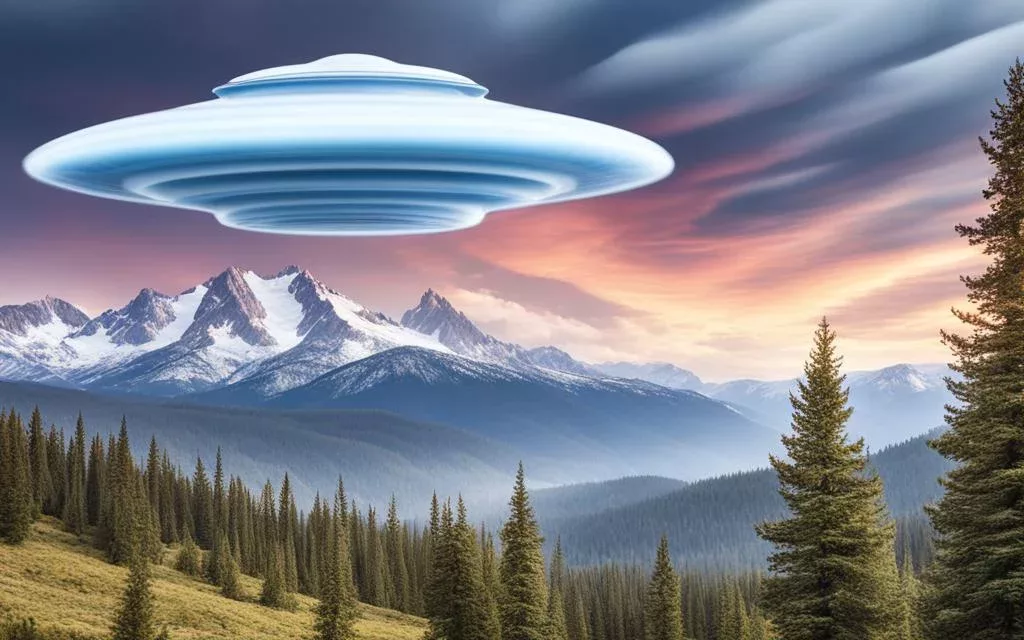
Public Fascination with Lenticular Clouds
Lenticular clouds have caught many people’s attention worldwide. Their look is similar to UFOs, sparking a lot of curiosity. Because of this, they’re often thought to be UFOs, making people speculate.
Their cylindrical shape makes them very intriguing. They have smooth layers that look like lenses. This unique shape makes them a beautiful sight in the sky.
People usually think lenticular clouds are from out of this world. They think these unique clouds are alien spaceships. This sparks a lot of talk among sky watchers and others.
These clouds are very popular online. Many people post amazing photos and videos of them. This leads to lots of discussions and admiration.
Even with scientific explanations for their shape, lenticular clouds still amaze us. They remind us of the beauty and complexity of our world.
Public Intrigue and UFO Sightings
Many people are fascinated by how much lenticular clouds look like UFOs. They’re often mistaken for unidentified flying objects. This is because of their unique shape and presence in the sky.
After these clouds appear, UFO sighting reports go up. Their striking look sparks imagination. It leads to talks about aliens and the unknown.
But it’s key to understand that lenticular clouds are natural. They form under certain conditions in the atmosphere. Even though they look like UFOs, they’re not from out of this world.
Lenticular clouds show us the beauty nature has to offer. They might not be aliens, but their interesting look still captures our imagination.
Lenticular Cloud Sightings Beyond New Hampshire
The recent sighting of the massive lenticular cloud in New Hampshire has amazed many. These clouds were seen from Bretton Woods, Mount Willard, North Conway, Ossipee, and even Maine. This shows just how far and wide lenticular clouds can be spotted in the Northeast.
“I couldn’t believe my eyes when I saw the colossal lenticular cloud hovering over Mount Willard. It was a surreal experience!”
Lenticular clouds can form in different places, from mountains to quiet towns. Seeing these unique clouds brings wonder and curiosity to those who see them.
In North Conway and Ossipee, viewers have seen the majestic lenticular clouds. These clouds make the beautiful scenery even more stunning. Both locals and visitors love this added beauty.
People from Maine and other areas have also shared their lenticular cloud pictures. The excitement about these clouds reaches far beyond New Hampshire. It brings together cloud lovers from everywhere to enjoy nature’s beauty.
Conservation of Lenticular Clouds and Their Environments
Lenticular clouds remind us to protect their natural homes. Places like Bretton Woods and Mount Willard are important for both nature and beauty.
Protecting these areas helps keep lenticular clouds around. It also keeps the local wildlife and ecosystems healthy. Saving natural places is vital for the clouds to form. This way, future generations will also get to see these wonders.
Fascinating Lenticular Cloud Sightings in New England
If you’ve never seen lenticular clouds, keep looking up in New Hampshire and Maine. You might see these amazing clouds anytime. Nature’s special show is always ready to surprise us.
| Location | Date | Description |
|---|---|---|
| Bretton Woods | July 17, 2022 | A majestic lenticular cloud formation soared above the iconic Mount Washington, casting a spell of enchantment on onlookers. |
| Mount Willard | August 2, 2022 | Hikers ascending Mount Willard were greeted by an awe-inspiring lenticular cloud, seemingly suspended in the cobalt-blue sky. |
| North Conway | September 5, 2022 | Lenticular clouds gracefully floated above the charming town of North Conway, leaving residents and visitors in awe of their ethereal beauty. |
| Ossipee | October 12, 2022 | An expansive lenticular cloud formation lent an air of mystery and wonder to the tranquil landscape of Ossipee, providing a breathtaking sight for all who beheld it. |
Lenticular clouds seen in many places show how fascinating they are. They quickly show up, leaving everyone who sees them amazed. It’s a reminder to enjoy the beauty above us.
Public Reactions to Lenticular Cloud Sightings
Lenticular clouds dazzle everyone. They quickly fill social media with pictures and videos. Everyone wants to share their amazement. People’s reactions range from surprise to praise, showing how these clouds amaze them.
Unforgettable Moments Captured in Social Media Posts
Lenticular clouds have become popular on social media. Photos and videos show their beauty, reaching more people. Fans of clouds and nature love to share and discuss these wonders.
Expressions of Public Amazement
“Seeing a lenticular cloud for the first time was unbelievable. It seemed like a dream! Nature’s beauty is astounding.”
“Lenticular clouds are stunning. They look like they defy gravity, hovering in the sky.”
“The day I saw a lenticular cloud, it felt like a personal show. It was incredible!”
Lenticular clouds spark wonder in everyone. These clouds look like spaceships, making people look twice. Each sighting brings excitement and curiosity.
| Social Media Platform | Number of Posts |
|---|---|
| 1,500+ | |
| 800+ | |
| 600+ | |
| TikTok | 400+ |
Social media is full of posts about these clouds. They let us see the sky’s beauty without leaving home. These images and videos are a virtual adventure in the sky.
People’s reactions to lenticular clouds show how much they love and respect nature. Sharing these moments brings us together. It makes us celebrate the amazing things in our world.
Conclusion
Lenticular clouds are fascinating. They show the beauty and intricacy of nature. Their lens shape and UFO look always amaze us. Understanding how they form helps us appreciate these wonders even more.
These clouds remind us of nature’s miracles. To see them, we need stable, fast air and high places. They signal pilots to avoid dangerous areas, keeping flights safe.
We must protect these natural spectacles. Conserving their habitats helps preserve these clouds and the life around them. Let’s cherish and protect these marvelous sights in our sky.
Source Links
- https://earthsky.org/earth/best-photos-beautiful-lenticular-clouds-around-the-world/
- https://www.metoffice.gov.uk/weather/learn-about/weather/types-of-weather/clouds/other-clouds/lenticular
- https://www.boston25news.com/news/local/did-double-take-stunning-photos-show-massive-ufo-like-cloud-formation-sky-over-new-hampshire/7TEBMUMIU5AIPNTOFRBOQKUDSA/

